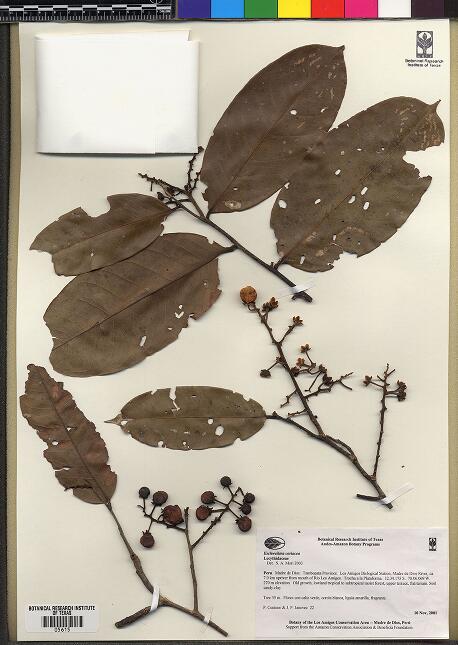Lecythidaceae
Eschweilera coriacea (DC.) S. A. Mori

Kingdom: Plantae Rank: Species Parent: Eschweilera Status: Valid
Common Names:
- Machimango, machimango blanco, machimango colorado. - English, Peru
Taxonomic Classification
Classification: The most widely spread of all Neotropical Lecythidaceae.
Morphological Description
Diagnosis: Buttressed trunks; outer bark brown to very dark brown in color; inflorescence rachises more-or-less zigzag; calyx-lobes puberulous and gibbous at the base; usually white petals with pale yellow androecial hood; and depressed globose fruits that are abruptly constricted below the calycine ring.
Vegetative Morphology
Habit: Trees, canopy, to 37 m tall. Trunk buttressed. Bark brown to very dark brown, more or less smooth, not noticeably fissured, peeling in irregular flakes, with vertically oriented lenticels, the inner bark 5-7 mm thick, yellowish-brown.
Leaves: Leaves with petioles 5-14 mm long; blades 9-26 x 4.5-12.5 cm, elliptic to narrowly elliptic or narrowly obovate to oblanceolate, glabrous; domatia absent; base acute to rounded; margins entire; apex acuminate; midrib plane at base adaxially, the secondary veins in 9-16 pairs.
Stipules: Stipules absent, at least in adults.
Exudate: Exudate absent.
Reproductive Morphology
Inflorescence: Inflorescences terminal or axillary, once-branched, paniculate, the second order rachis often poorly developed or sometimes absent, the principal rachis puberulous, with simple trichomes, often zigzag; pedicels articulate, 1-2 mm below and 10-20 mm long above articulation, the basal portion persisting as knobs after flowers fall.
Flowers: Flowers 3.5-5 cm diam.; hypanthium puberulous, calyx lobes 3-9 x 3-7 mm, very widely ovate to ovate, slightly gibbous at base, puberulous; petals usually white; androecial hood usually pale yellow; style erect.
Fruit: Fruits dehiscent, 3-4 (excluding operculum) x 3.5-8 cm, depressed globose, usually abruptly contracted directly below calycine ring, often drying black; the operculum dome-shaped.
Seeds: . Seeds with well-developed lateral aril.
Other
Uses: There are no reported uses of this species.
Distribution: Eschweilera coriacea has one of the widest distributions of Neotropical Lecythidaceae. It is found in eastern Panama, northwestern Colombia, and Amazonian Colombia, Venezuela, Ecuador, Peru, and Brazil as well as in all three of the Guianas. See map (Fig. 74) in Mori and Prance (1990).
Ecology: Eschweilera coriacea is a canopy tree of non-flooded forests where it can be one of the more common species. In central French Guiana, 13.9 individuals over 10 cm DBH per hectare have been recorded (Mori & Boom, 1987) and in a 100 hectare plot in Amazonian Brazil north of Manaus 1539 of the 7791 trees of Lecythidaceae over 10 cm DBH are this species (Mori & Lepsch-Cunha, 1995)
Chromosome Number: Unknown.
Notes: In central French Guiana, Eschweilera coriacea flowers in the dry season in late October and early November, and it has also been documented to flower from October to November, which is the later part of the dry season, at Reserve 1501 located in undisturbed forest north of Manaus. At Reserve 1501, seeds are dispersed from January to February and seedlings have been collected in March. There are no pollination biology studies of this species, but its flowers, which produce nectar as a pollinator reward, are most likely pollinated by bees. The seeds have a fleshy lateral aril that may be sought after by bats and they could also be secondarily scattered hoarded by rodents; there are, however, no observations to support either of these suggestions.
Typification
Type Citation: Fl. Neotrop. Monogr. 21(II): 203-207. 1990.
Basionym: Lecythis coriacea
Basionym Citation: Prodr. 3: 291. 1828.
Type Locality: Brazil. Amazonas: Ega.
Type Collection: Martius 2905
Types Deposited at: Holotype: Lectotype, M, photo NY; Isotypes: Isolectotypes, BM – fragment, K, photo NY - K neg. 16389, M
Other Published Figures: Spichiger, R. et al. 1990. Contribución a la flora de la Amazonia Peruana, vol.2, pp 301-303,. Fig. 131 – habit, flowers